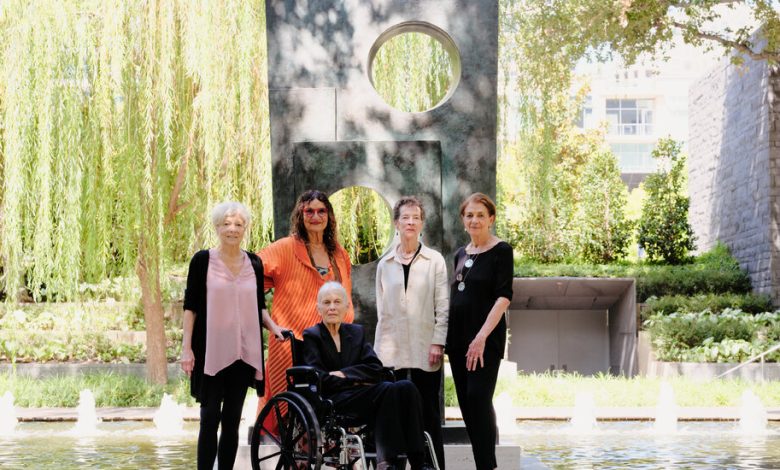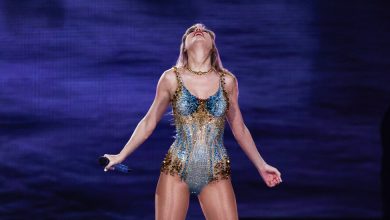Women of ‘Groundswell’: Thinking Outside the Spiral

The land art movement, which flourished in the ’70s amid enormous media attention, at times seemed like a boys’ club. When Michael Heizer dynamited the Nevada earth to create his “Double Negative,” or when Robert Smithson built his “Spiral Jetty” from a 1,500-foot coil of basalt rocks on the shore of the Great Salt Lake, they expanded the proportions of contemporary art to a scale that owed as much to ancient sites like Stonehenge as to the cowboy fantasy of the infinitely expandable frontier.
Tellingly, I recently looked up the artist Nancy Holt in Robert Hughes’s “American Visions: The Epic History of Art in America” (1997), one of the leading survey books on the art of this country. Its cover is graced with a sweeping nighttime view of Walter de Maria’s “Lightning Field,” which, conveniently, produced a flash of lightning that crackles down the book’s spine.
As it turned out, Holt is not listed in the index of the book, nor is Mary Miss nor Alice Aycock. And where, for the matter, are Meg Webster, Michelle Stuart and Ana Mendieta, the Cuban American artist who once burned her silhouette into the landscape? Add to that Lita Albuquerque, Maren Hassinger, Patricia Johanson, Beverly Buchanan, Jody Pinto and Agnes Denes, the last of whom once turned Battery Park Landfill in Manhattan into a rectangle of incandescent yellow by planting two acres of wheat.
All 12 can now be found at the Nasher Sculpture Center in Dallas — in “Groundswell: Women of Land Art,” a fresh and fascinating attempt to update the land-art canon. Organized by Leigh A. Arnold, the show looks back a half-century at work that is rooted in the American avant-garde of the ’70s, that shaggy decade in which the rise of second-wave feminism collided with the back-to-nature ethos of hippiedom. Those two movements inform many of the works in the show, which doesn’t mean they are easy to showcase. Land art glorified the ephemeral gesture over the salable art object. Some of its masterpieces blew away in the wind and survive only as photographs of remote fields taken from a helicopter at a headache-inducing angle.
Still, land art is a superb subject for reconsideration; it was never more relevant than it is today. In our age of environmental catastrophe, land art needs to be recognized and reframed as a morally precocious movement. Its practitioners were ahead of their time in understanding that caring for our home is not a matter of ordering blinds or a new fridge but of acknowledging the limited resources of the planet Earth.
The Nasher show, which extends from the museum’s galleries into the oxygenated outdoors, includes a few new sculptures as well. Mary Miss, an environmentally minded sculptor of 79 who lives in New York, achieves something exquisite in “Stream Trace: Dallas Branch Crossing,” a multisite installation that originates in the museum’s sculpture garden and leads you on a walk. (Land art was always about walking as much as looking.) A procession of stainless-steel poles crowned by shiny X’s trace the path of the Dallas Branch, a still-existent stream that runs below the sculpture garden.
Miss, in other words, is a cross between a sculptor and a land surveyor. On the day I visited, the temperature was in the 90s and the streets were baking and it was pleasing to think back to the city’s pre-paved past.
One theme that runs through the show, like Miss’s buried stream, is the desire of a generation to escape the Minimalist box, which dominated sculpture in the ’60s and filled galleries with blocky, inexpressive volumes. You can see Minimalism literally shatter into pieces in Alice Aycock’s “Clay #2,” a kind of manifesto in mud. Originally done in 1971 and re-created for the Nasher show, the piece consists of a large, floor-hugging, sandbox-like structure divided into 16 evenly spaced squares, all of them filled with red clay that is still in the process of drying. The surface is full of long cracks and radiates a surprising integrity, not unlike Georgia O’Keeffe’s wrinkles.
Meg Webster, too, embraces the “sensual grid,” to borrow a term from the feminist critic Lucy Lippard, to describe art that veers between extremes of order and release. Webster’s “Moss Bed, Queen” (1986/2005), a mattress-shaped object set flat on the floor in the Nasher lobby, is sprouting thick, velvety layers of still-growing moss. It needs to be watered once a day. Frankly, it feels less like a sculpture than a pet.
The most prominent among the female land artists was Holt, a self-effacing perfectionist from Worcester, Mass., who studied biology at Tufts University and married Robert Smithson. They were the First Couple of Land Art, and her best-known piece, “Sun Tunnels,” shares a Utah address with his “Spiral Jetty.” Holt began the piece in 1973, the same year that Smithson was tragically killed, at age 35, in an airplane crash above a site he was surveying in Amarillo, Texas. His death only increased the reverence for his work. The form of the spiral — open, curving, conjuring infinities — became as ubiquitous in the art of the late ’70s as the box had been in the ’60s.
Holt turned Smithson’s spiral into a viewing device. Her “Sun Tunnels,” seen in photographs, consist of four mammoth concrete pipes that frame the desert sun exactly twice a year, on the summer and winter solstices. While Smithson decentered the gaze (think of all that walking), Holt re-centered it. It was as if she wanted to compress the beauty of the world into a single, concentrated, sumptuous glimpse.
At the Nasher, be sure to look for her “Locator (P.S. 1),” of 1980, a tall, skinny, deceptively simple sculpture comprised from two pipes, the shorter one angled on top of the other. When I peered into the opening, a black, almost-vibrating orb sprang into view. It had been painted on the ceiling of the gallery, although I had not noticed it before.
Smithson is not included in the show, but is present everywhere by implication. The cover of the “Groundswell” catalog shows a detail of Lita Albuquerque’s “Spine of the Earth” (1980), a since-vanished artwork in the Mojave whose central spiral — done in red powdered pigment — looks like colorized Smithson.
Albuquerque, now 77, who lives in California, also provides the exhibition with a pop mascot, “Najma Returns,” an ultramarine-blue, life-size sculpture of a woman that greets visitors in the lobby of the museum. Whether or not you engage with its operatic back story — Najma is a 25th-century astronaut with ideas about the cosmos — Albuquerque’s way with color enchants. I found myself oohing before her “Untitled,” a foot-and-a-half-high granite rock dusted in a coat of Prussian blue powdered pigment that looks as if it fell to earth from a yet-to-be-discovered cerulean planet.
For all its engaging and poetic moments, “Groundswell” can feel disjointed. The Nasher’s beautifully proportioned Renzo Piano building has an intimate scale perhaps better suited to monographic tributes than to intricate survey shows. Moreover, the omission of land art’s male practitioners leaves large gaps in the story.
“I think that while we want to make sure that women get their just due, remember, we were in dialogue with the guys,” said Alice Aycock, when we talked at the opening.
Conversely, the guys were in dialogue with her. At one point, Aycock and I were looking at an aerial photograph of her “Maze,” a sculptural installation that no longer exists. She built it in 1972, on a farm near New Kingston, Pa., and it recasts the form of the spiral as a six-foot-tall architectural structure complete with doorways and winding halls.
“Maze” has been cited by art historians as an influence on Robert Morris, the theatrically brainy founder of Minimalism, with whom Aycock studied at Hunter College. As Aycock explained, without any bitterness, “Immediately after my master’s thesis, I made the maze. I came back and showed it to Bob” — she was referring to documentary photographs — “and Bob made the maze and got it on the cover of Artforum. That was Bob.”
She meant that he succeeded in catapulting his own maze-themed sculpture, not hers, onto the cover of the influential magazine that once served as the bible of Minimalism. A few days later, at my desk in New York, I looked up the issue. Morris’s “Labyrinth” appeared on the cover of the September 1974 issue. The accompanying article, by Jeremy Gilbert Rolfe, made no mention of Aycock.
Not that every little borrowing in art needs to be formally acknowledged. But it is nice to give credit where credit is due. Wanting to read more about Aycock’s “Maze,” I reached for the catalog of “Groundswell,” a 255-page, well-designed volume.
But when I tried to look up Aycock in an index, I was surprised to realize the book doesn’t have one, and I could no more consult page listings for her work than I could in the Robert Hughes tome published a generation ago. The “Groundswell” catalog, like the exhibition itself, is organized along broad themes such as “Structured Power,” to cite one heading. The absence of an index in the catalog shortchanges the dozen artists in the show and anyone trying to research their work.
As much as the Nasher is to be commended for its recuperative efforts on behalf of female land artists, art is not made by movements. It is made by individuals who have given it their all, and one hopes that future exhibitions of land art will do a better job of saying their names.
Groundswell: Women of Land Art
Through Jan. 7, 2024, Nasher Sculpture Center, Dallas; (214) 242-5100; nashersculpturecenter.org.



